 "ttyymmnn" (ttyymmnn)
"ttyymmnn" (ttyymmnn)
09/02/2016 at 12:35 • Filed to: Planelopnik, planelopnik history
 8
8
 22
22
 "ttyymmnn" (ttyymmnn)
"ttyymmnn" (ttyymmnn)
09/02/2016 at 12:35 • Filed to: Planelopnik, planelopnik history |  8 8
|  22 22 |
Welcome to This Date in Aviation History , getting of you caught up on milestones, important historical events and people in aviation from August 31 through September 2.
!!! UNKNOWN CONTENT TYPE !!!
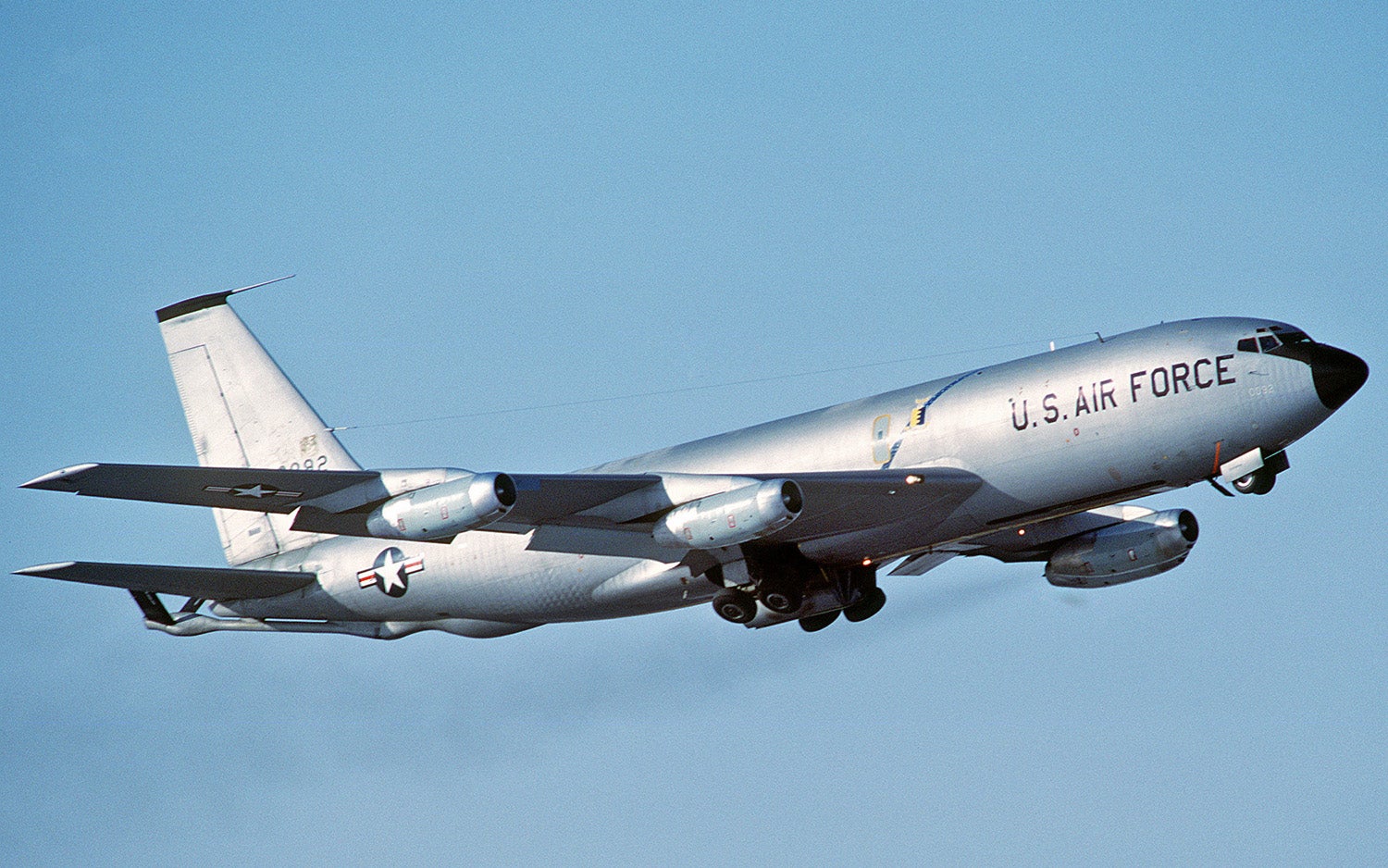
August 31, 1956 – The first flight of the Boeing KC-135 Stratotanker. One of the earliest successful, and even remotely practical, experiment with aerial refueling occurred in 1923, when one US Army Air Forces !!!error: Indecipherable SUB-paragraph formatting!!! biplane refueled another through a hose draped between the two aircraft. America’s first dedicated strategic tanker, a variant of the !!!error: Indecipherable SUB-paragraph formatting!!! , entered service in 1951 but, as the US Air Force entered the jet age, it quickly became apparent that propeller-powered aerial tankers were not fast enough to keep up with the new jet-powered fighters and bombers. In 1954, the Air Force announced its intention to procure a modern tanker/transport aircraft to replace the KC-97, and both Boeing and Lockheed competed for the contract. Lockheed proposed the !!!error: Indecipherable SUB-paragraph formatting!!! , a design with two rear-mounted engines, and Boeing offered a version of their !!!error: Indecipherable SUB-paragraph formatting!!! , better known as the Dash 80, a proof-of-concept aircraft that would also be developed into the the !!!error: Indecipherable SUB-paragraph formatting!!! . Though the Lockheed design was declared the winner, their aircraft was still on the drawing board while the Boeing design was already flying and could be delivered two years ahead of the L-193. So the Air Force changed its mind and selected the Boeing design, which they designated the KC-135 (Boeing initially gave the aircraft the designation 717, and it actually predates the civilian 707 airliner). Though the KC-135 and 707 look very similar, the KC-135 is shorter and narrower than its airliner sibling though, at least initially, they were both powered by the same !!!error: Indecipherable SUB-paragraph formatting!!! (P&W designated the engine the JT3C) axial flow turbojet engines. Acting as both an aerial refueler and a cargo plane, the KC-135 could carry more than 31,000 pounds of fuel, a dramatic increase over the 14,900 pounds carried by the KC-97, and could accommodate up to 83,000 pounds of fuel and cargo combined.
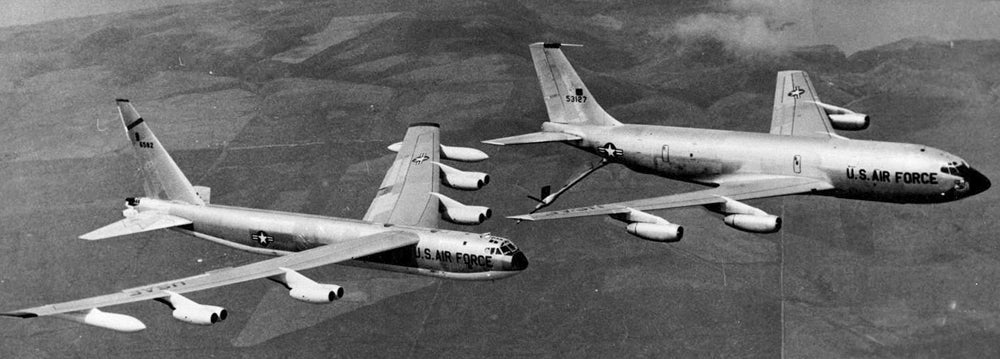
In the strategic refueling role, the Air Force expected the KC-135 to provide refueling for long-range
!!!error: Indecipherable SUB-paragraph formatting!!!
(SAC) bombers such as the
!!!error: Indecipherable SUB-paragraph formatting!!!
and
!!!error: Indecipherable SUB-paragraph formatting!!!
. However, during the Vietnam War, the Air Force (and US Navy and Marine Corps) learned that having tankers on station near the battlefield could dramatically extend the loiter time of fighters and attack aircraft. Planes that could once only spend minutes over a target could now stay for hours with aerial refueling. So the KC-135, which was originally fitted with the
!!!error: Indecipherable SUB-paragraph formatting!!!
refueling probe used by Air Force aircraft, was modified to support the
!!!error: Indecipherable SUB-paragraph formatting!!!
system in use by the Navy and Marine Corps. The Stratotanker has been continually upgraded throughout its service life, receiving more powerful and fuel efficient engines and improved avionics, and provides refueling services the world over. In ten years of production from 1955-1965, Boeing built just over 800 KC-135s, and it was exported in small numbers to Chile, France, Singapore and Turkey. In current service, the strategic refueling role has largely been supplanted by the bigger
!!!error: Indecipherable SUB-paragraph formatting!!!
, while the KC-135 has taken on the tactical refueling role. The KC-135 is also one of only a small handful of aircraft to log over 50 years of service. Starting in 2018, the KC-135 will begin to be replaced by the
!!!error: Indecipherable SUB-paragraph formatting!!!
, which is a development of the
!!!error: Indecipherable SUB-paragraph formatting!!!
airliner.
(US Air Force photos)
!!! UNKNOWN CONTENT TYPE !!!

September 1, 1983 – Korean Air Lines Flight 007 is shot down by Russian fighters. Following the end of WWII in 1945, the United States and the Soviet Union, allies in the fight against Hitler’s Germany, quickly became ideological enemies, starting a !!!error: Indecipherable SUB-paragraph formatting!!! that would last for more than forty years. In the time before reliable spy satellites, Russia and America used aircraft to keep watch on each other, and a number of American aircraft were !!!error: Indecipherable SUB-paragraph formatting!!! or shot down by Russian fighter jets to keep the prying eyes away from Russian airspace. But even in an age of modern satellites, the Russians remained on edge about aircraft intruding into their airspace, and even went so far as to shoot down a civilian airliner that they believed was on a covert spy mission. Korean Air Lines Flight 007 was a scheduled !!!error: Indecipherable SUB-paragraph formatting!!! (HL7442) flight from New York City to Seoul, South Korea, with a stop in Anchorage, Alaska. Onboard were 246 passengers and 23 crew, along with US Congressman !!!error: Indecipherable SUB-paragraph formatting!!! of Georgia, who was on his way to South Korea for a ceremony recognizing the anniversary of the mutual defense pact signed between South Korea and the US. After departing from Anchorage, Flight 007 headed towards South Korea on North Pacific (NOPAC) route Romeo 20 (R-20), which would take it within 17.5 miles of Soviet airspace off the !!!error: Indecipherable SUB-paragraph formatting!!! . Ten minutes after takeoff, Flight 007 began to divert from its intended flight path, most likely due to an improperly set autopilot system, and the pilots failed to monitor their position, placing them on a course to cross the southern end of the Kamchatka Peninsula near the city of Petropavlovsk, which was home to the Soviet Union’s largest Pacific submarine base during the Cold War.
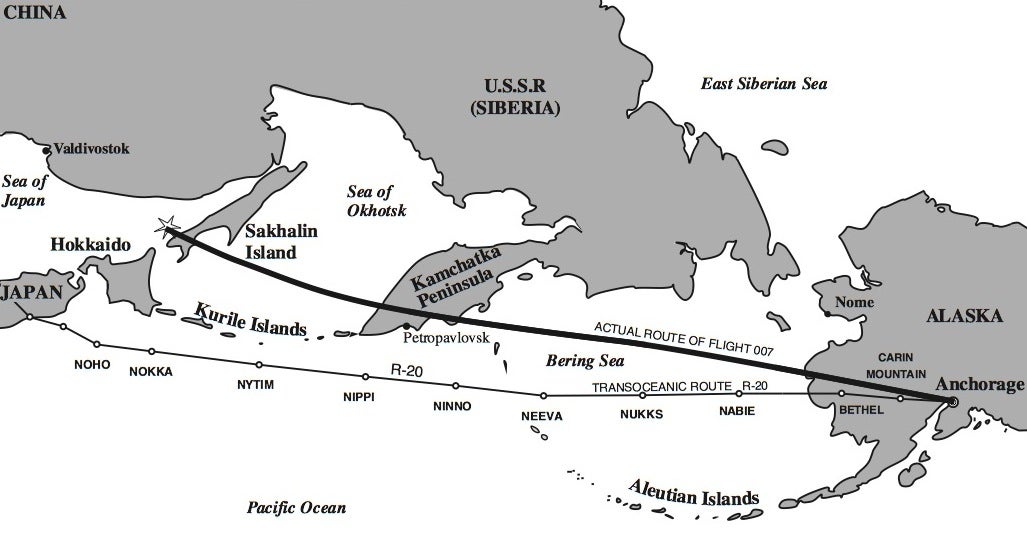
At the time, tensions between the US and Russia were at a height not seen since the
!!!error: Indecipherable SUB-paragraph formatting!!!
in 1962. The US was working on the
!!!error: Indecipherable SUB-paragraph formatting!!!
(SDI, popularly referred to as Star Wars) to protect the US from nuclear missiles, they were working to stage
!!!error: Indecipherable SUB-paragraph formatting!!!
ballistic nuclear missiles in Europe that could reach Moscow in just 10 minutes, and they were in the middle of a huge naval exercise, FleetEx ‘83, which was being held in the north Pacific. Soviet General Secretary
!!!error: Indecipherable SUB-paragraph formatting!!!
was convinced that the US was planning a preemptive nuclear strike, and the Russian military was on high alert. Soviet defense radars detected and tracked Flight 007 as it approached Russian airspace, and
!!!error: Indecipherable SUB-paragraph formatting!!!
and
!!!error: Indecipherable SUB-paragraph formatting!!!
were dispatched to intercept it. After much confusion and discussion by Russian military brass, the order was given to shoot down the airplane, whether it was civilian or not. One of the Su-15s maneuvered behind the airliner and fired two
!!!error: Indecipherable SUB-paragraph formatting!!!
air-to-air missiles, which damaged the hydraulics systems of the plane and caused the cabin to depressurize. The pilots fought to control the plane, but it eventually spiraled into the water near
!!!error: Indecipherable SUB-paragraph formatting!!!
in the Sea of Japan, killing all on board. Initially, the Russians said nothing about the shoot down, believing that their role could not be proven. Eventually, they admitted to downing the airliner, alleging that it was part of a planned intelligence gathering mission, and suggesting that the fighter pilots had mistaken the airliner for a
!!!error: Indecipherable SUB-paragraph formatting!!!
reconnaissance plane, one of which actually was operating in the area at the time. While all indications are that it was a simple mistake of navigation, many questions linger over the real story of Flight 007. Driven mostly by the inability to find the bodies of the passengers, a
!!!error: Indecipherable SUB-paragraph formatting!!!
persists, from a purposeful course deviation to monitor the Russian response, to a forced landing and the incarceration of the passengers and crew. Others suggest that it was part of a massive, unreported aerial battle between the US and Russia. Following the disaster, the US, Japan and the Soviet Union began to cooperate on radar tracking of aircraft in the north Pacific, and President
!!!error: Indecipherable SUB-paragraph formatting!!!
announced in 1983 that the
!!!error: Indecipherable SUB-paragraph formatting!!!
(GPS) would be made available for civilian use.
(Illustration author unknown,
!!!error: Indecipherable SUB-paragraph formatting!!!
; map by NASA)
!!! UNKNOWN CONTENT TYPE !!!
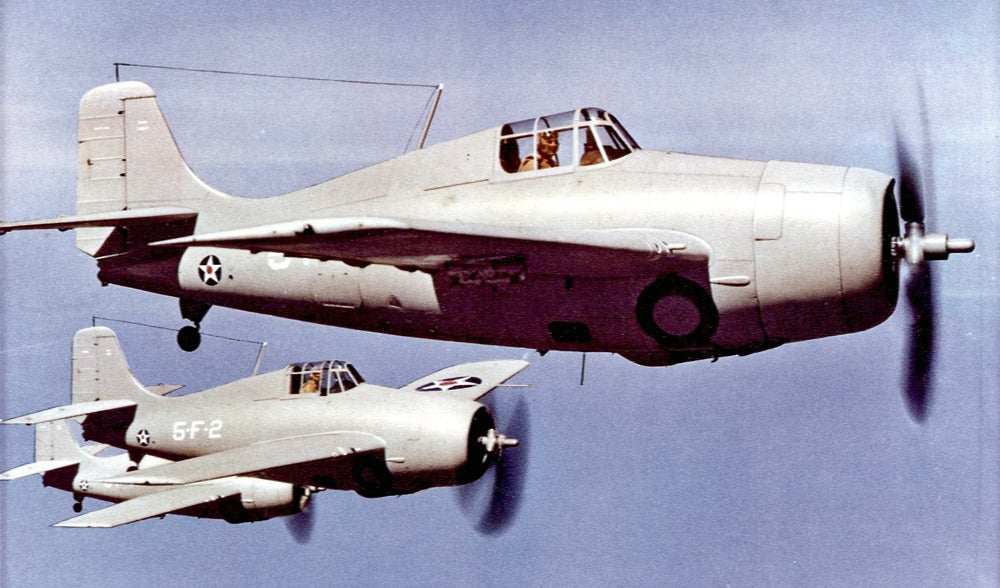
September 2, 1937 – The first flight of the Grumman F4F Wildcat. Grumman has a history of making rugged, strong fighter aircraft, a tradition that can be traced all the way back to the days before WWII. Their penchant for making reliable aircraft that could take a pounding earned them the nickname “Iron Works,” and the first aircraft to truly live up to that name was the F4F Wildcat. The Wildcat traces its lineage back to the first biplane fighter that Grumman produced for the Navy, the !!!error: Indecipherable SUB-paragraph formatting!!! , which was notable for being the first carrier-based fighter to feature a retractable landing gear. Grumman continually developed their fighter, first with the F2F, then the F3F, and though both of those iterations were biplane fighters, the classic F4F fuselage began to take shape. Even while the F3F was undergoing flight testing, Grumman was looking ahead to their next fighter, another biplane, but by that time the Navy had made the decision to select a monoplane design with the !!!error: Indecipherable SUB-paragraph formatting!!! . Still, the Navy placed an order for Grumman’s newest biplane, the G-16, in case the Buffalo didn’t fulfill their needs. The G-16, soon to be called the XF4F-1, turned out to be inferior to the Buffalo, so Grumman went back to the drawing board and adopted a monoplane design, giving their fighter new wings and tail, and beefing up the power with a supercharged !!!error: Indecipherable SUB-paragraph formatting!!! radial engine. This aircraft would be the XF4F-3, and the classic Wildcat had taken shape.

Grumman XF4F-3 prototype
The US Navy placed an order for the new fighter, as did France, but when France fell to Germany in 1940, those aircraft were sent to England, where they were known as the Martlet and saw their first combat with the Royal Navy’s Fleet Air Arm. When war broke out in the Pacific in 1941, the Buffalo, which had been chosen over the Wildcat, proved to be nearly useless against modern Japanese fighters, and it was quickly withdrawn in favor of the Wildcat. While the Wildcat was still no match for the Japanese
!!!error: Indecipherable SUB-paragraph formatting!!!
head-to-head, it was still better than the woefully underperforming Buffalo. The Wildcat’s strong construction, armored cockpit, and self-sealing fuel tanks allowed it to absorb punishment from Japanese fighters and stay in the fight while bringing its pilots home, and special tactics, such as the
!!!error: Indecipherable SUB-paragraph formatting!!!
, helped keep the Wildcat effective until the more powerful
!!!error: Indecipherable SUB-paragraph formatting!!!
arrived in the Pacific in 1943. By the end of the war, and despite the Zero’s greater maneuverability, better climb rate, and longer range, the Wildcat—and her well-trained pilots—enjoyed an almost 7:1 kill ratio over the enemy. The Wildcat would serve the Navy and Marine Corps throughout the war and, with the arrival of the Hellcat, the Wildcat shifted operations to escort carriers that were too small for the larger fighters, and helped provide air cover for amphibious assaults. By the end of production in 1945, nearly 8,000 Wildcats had been built, and it was retired at the end of the war.
(US Navy Photos)
!!! UNKNOWN CONTENT TYPE !!!
Short Takeoff
!!! UNKNOWN CONTENT TYPE !!!
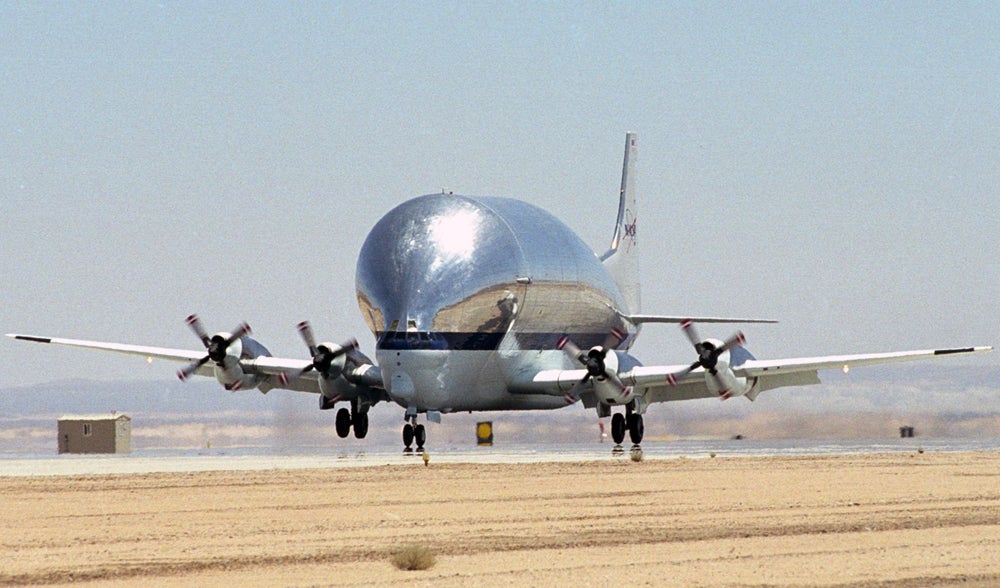
August 31, 1965 – The first flight of the Aero Spacelines Super Guppy,
a wide-body, oversize cargo carrier and successor to the
!!!error: Indecipherable SUB-paragraph formatting!!!
. The Super Guppy was built on the fuselage of a
!!!error: Indecipherable SUB-paragraph formatting!!!
, itself the military version of the
!!!error: Indecipherable SUB-paragraph formatting!!!
. Upgraded
!!!error: Indecipherable SUB-paragraph formatting!!!
turboprop engines allowed the Super Guppy to carry a load of 54,000 pounds at 300 mph, and it was used notably for carrying large pieces of the
!!!error: Indecipherable SUB-paragraph formatting!!!
spacecraft. Only one Super Guppy was built before further developments led to the Super Guppy Turbine, of which four were built.
(NASA Photo)
!!! UNKNOWN CONTENT TYPE !!!
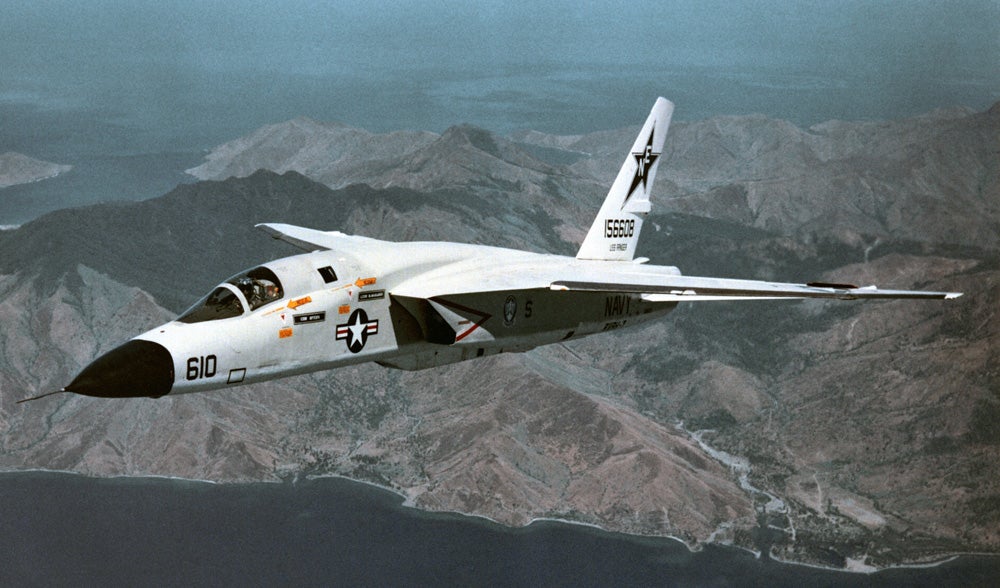
August 31, 1958 – The first flight of the North American A-5 Vigilante, an all-weather, carrier-borne, supersonic nuclear strike aircraft designed for the US Navy to replace the !!!error: Indecipherable SUB-paragraph formatting!!! . Despite its intended role as a nuclear bomber, the Vigilante performed predominately in the role of tactical strike and reconnaissance as the RA-5C, seeing extensive action in the Vietnam War. With a crew of two, the Vigilante was one of the largest aircraft ever to operate regularly from a US carrier, and was retired in 1979 as multi-role fighters took over its reconnaissance and strike missions. (US Navy Photo)
!!! UNKNOWN CONTENT TYPE !!!
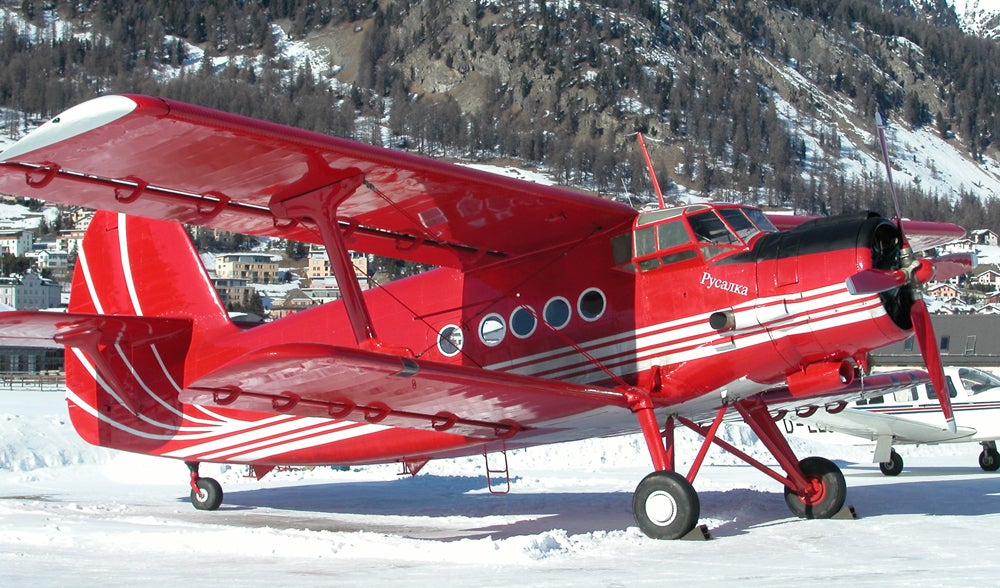
August 31, 1947 – The first flight of the Antonov An-2, a jack-of-all-trades biplane produced in large numbers by the Soviet Union. Over 18,000 copies of this rugged, single-engine biplane have been built since production began in 1947 and, when production ceased in 2001, it marked the end of a 54-year production run surpassed only by the !!!error: Indecipherable SUB-paragraph formatting!!! . The An-2 saw combat during the Korean War, but it exists today in a host of variants for all manners of reconnaissance, utility, agricultural top dressing, and survey work, just to name a few. Antonov further developed the biplane into the !!!error: Indecipherable SUB-paragraph formatting!!! , with a turboprop engine replacing the radial engine, but only 25 were built. (Photo by Roeme via !!!error: Indecipherable SUB-paragraph formatting!!! )
!!! UNKNOWN CONTENT TYPE !!!
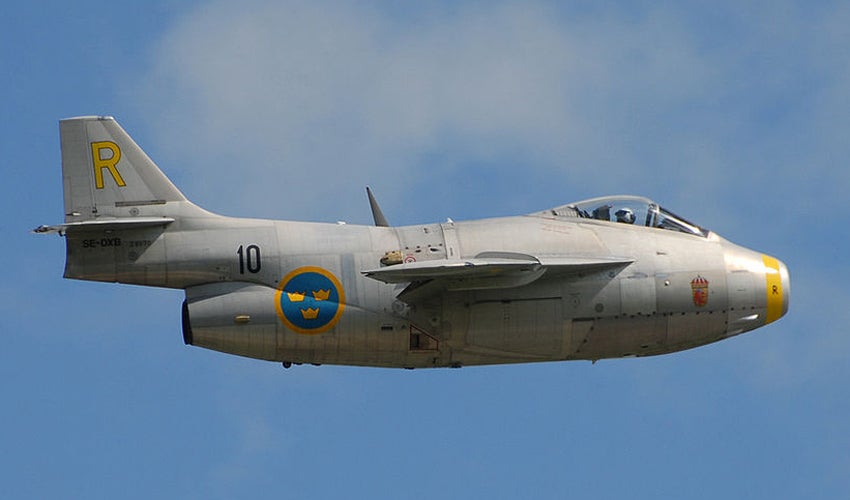
September 1, 1948 – The first flight of the Saab J-29, Sweden’s second turbojet fighter following the !!!error: Indecipherable SUB-paragraph formatting!!! and the first Western European fighter to be built with a swept swing following WWII. Nicknamed Tunnan ( Barrel ), the J-29 was, despite its ungainly appearance, a highly effective and agile fighter that served the Swedish Air Force for over 25 years before its retirement in 1976. The J-29 was powered by a single Svenska Flygmotor RM 2B turbojet (a license-built !!!error: Indecipherable SUB-paragraph formatting!!! ) that gave it a maximum speed of 660 mph and was armed with a four 20mm cannons as well as rockets or air-to-air missiles. A total of 661 were produced from 1948-1956, and it was retired in 1976. (Photo by John5199 via !!!error: Indecipherable SUB-paragraph formatting!!! )
!!! UNKNOWN CONTENT TYPE !!!

September 2, 1998 – The first flight of the Boeing 717, a twin-engine, narrow-body commercial airliner first developed by McDonnell Douglas as the MD-95, the final variant of the venerable !!!error: Indecipherable SUB-paragraph formatting!!! line. Following the merger of McDonnell Douglas and Boeing in 1997, the MD-95 was rebranded as the Boeing 717 (not to be confused with the earlier military version of the Boeing 367-80 that would enter service as the !!!error: Indecipherable SUB-paragraph formatting!!! ), and the 717 entered service in 1999 with !!!error: Indecipherable SUB-paragraph formatting!!! (formerly !!!error: Indecipherable SUB-paragraph formatting!!! ) as a medium-range airliner for the 100-seat market. When production ended in 2006, a total of 156 had been produced. (Photo by Airwim via !!!error: Indecipherable SUB-paragraph formatting!!! )
!!! UNKNOWN CONTENT TYPE !!!

September 2, 1949 – The first flight of the de Havilland Venom, a single-engine, turbojet-powered fighter-bomber developed from the !!!error: Indecipherable SUB-paragraph formatting!!! . The twin-tail boom configuration allowed for a shorter tailpipe behind the engine to take advantage of as much power as the early !!!error: Indecipherable SUB-paragraph formatting!!! turbojet could offer. Like the Vampire, the Venom was still built from a composite of wood and metal, but a thinner wing allowed greater speeds, while wingtip fuel tanks increased range. The Venom was introduced in 1952, and was the first British fighter to be fitted with an ejection seat. The Venom served the RAF until 1962, and with the Swiss Air Force until 1983. (Photo by Hermann Keist via !!!error: Indecipherable SUB-paragraph formatting!!! )
!!! UNKNOWN CONTENT TYPE !!!

September 2, 1942 – The first flight of the Hawker Tempest,
an improved version of the
!!!error: Indecipherable SUB-paragraph formatting!!!
fighter-bomber. The Tempest benefited from a more powerful engine and a new,
!!!error: Indecipherable SUB-paragraph formatting!!!
, and became a formidable attack aircraft. The Tempest was one of the most powerful fighters of the war, and possessed particularly good low-level performance. The Tempest was powered by a single
!!!error: Indecipherable SUB-paragraph formatting!!!
liquid-cooled 24-cylinder engine that developed around 3,000 hp, had a top speed of 432 mph, and was armed with four 20 mm
!!!error: Indecipherable SUB-paragraph formatting!!!
cannons and up to 1,000 pounds of bombs or rockets. Introduced in January 1944, just over 1,700 Tempests were produced, and it was retired following the war.
(RAF Photo)
!!! UNKNOWN CONTENT TYPE !!!
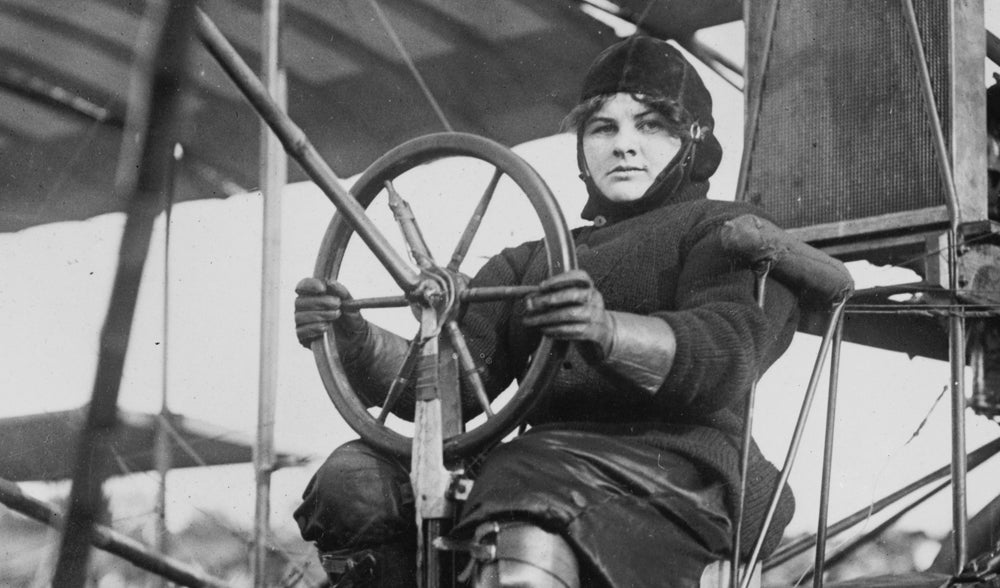
September 2, 1910 – Blanche Stuart Scott makes the first solo airplane flight by a woman in the United States. An adventurer at heart, Scott was the second woman to drive an automobile across the United States, and her notoriety led to an offer from !!!error: Indecipherable SUB-paragraph formatting!!! to give her flying lessons. Scott went on to become a professional pilot, making her debut as a member of the Curtiss exhibition team as the first woman to fly at a public event, earning her the nickname “Tomboy of the Air.” After gaining fame as a stunt pilot, Scott was the first American woman to make a long-distance flight of 60 miles, and also became a test pilot for !!!error: Indecipherable SUB-paragraph formatting!!! . She retired from flying in 1916 because she was upset by an American public that seemed obsessed with air crashes, and the lack of opportunity for women pilots. (Library of Congress photo)
!!! UNKNOWN CONTENT TYPE !!!
Recent Aviation History Posts
!!! UNKNOWN CONTENT TYPE !!!
!!! UNKNOWN CONTENT TYPE !!!
!!! UNKNOWN CONTENT TYPE !!!
!!! UNKNOWN CONTENT TYPE !!!
If you enjoy these Aviation History posts, please let me know in the comments. And if you missed any of the past articles, you can find them all at
!!!error: Indecipherable SUB-paragraph formatting!!!
.
!!! UNKNOWN CONTENT TYPE !!!
 McMike
> ttyymmnn
McMike
> ttyymmnn
09/02/2016 at 12:47 |
|
The Vigilante was one of the largest aircraft ever to operate regularly from a US carrier.
It could carry a lot of difference payloads.
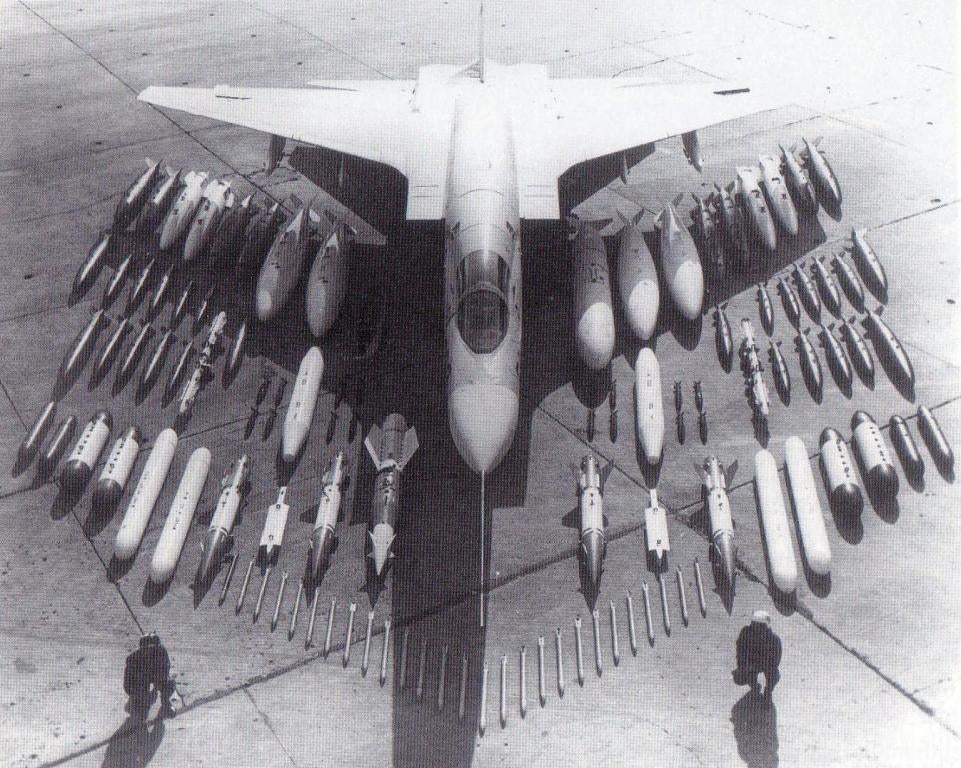
However, of all the payloads it could carry, I think this was its least favorite.
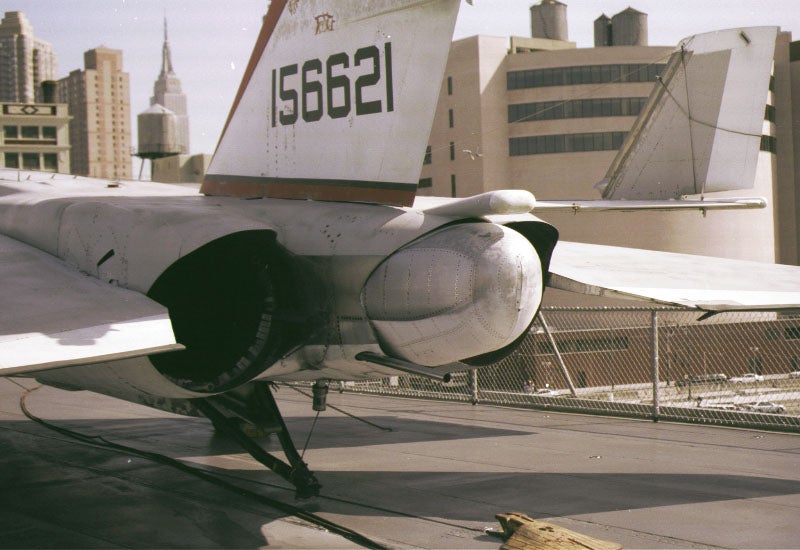
 Smallbear wants a modern Syclone, local Maple Leafs spammer
> ttyymmnn
Smallbear wants a modern Syclone, local Maple Leafs spammer
> ttyymmnn
09/02/2016 at 12:57 |
|
Always bugged me that “717" wasn’t used. Looks like it bugged Boeing too.
 Roundbadge
> McMike
Roundbadge
> McMike
09/02/2016 at 13:05 |
|
That tail-section bomb bay is fascinating. I never knew about that until minutes ago. Thanks!
 MonkeePuzzle
> ttyymmnn
MonkeePuzzle
> ttyymmnn
09/02/2016 at 13:50 |
|
did not know this was a thing. always cool to find out about a new plane
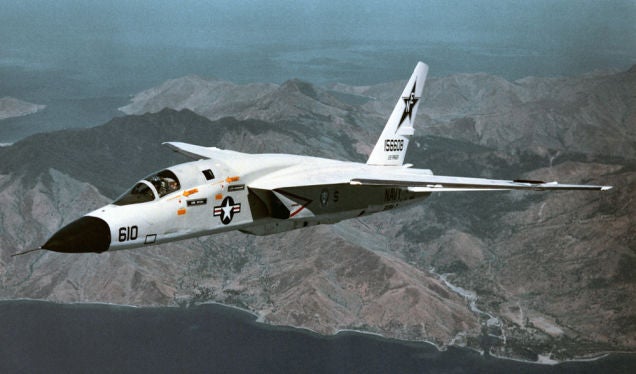
 ttyymmnn
> Smallbear wants a modern Syclone, local Maple Leafs spammer
ttyymmnn
> Smallbear wants a modern Syclone, local Maple Leafs spammer
09/02/2016 at 14:11 |
|
They did use it, they just didn’t put it into production.
 Smallbear wants a modern Syclone, local Maple Leafs spammer
> ttyymmnn
Smallbear wants a modern Syclone, local Maple Leafs spammer
> ttyymmnn
09/02/2016 at 14:12 |
|
Must google. I’ve never heard of it.
 ttyymmnn
> McMike
ttyymmnn
> McMike
09/02/2016 at 14:13 |
|

It even looks like a turd.
 ttyymmnn
> Smallbear wants a modern Syclone, local Maple Leafs spammer
ttyymmnn
> Smallbear wants a modern Syclone, local Maple Leafs spammer
09/02/2016 at 14:15 |
|
It’s in my post. Boeing called the KC-135 the 717 at first, even though it actually predates the 707. Not sure how that worked out, though.
 Smallbear wants a modern Syclone, local Maple Leafs spammer
> ttyymmnn
Smallbear wants a modern Syclone, local Maple Leafs spammer
> ttyymmnn
09/02/2016 at 14:17 |
|
(Boeing initially gave the aircraft the designation 717, and it actually predates the civilian 707 airliner)

Missed that completely.
 ttyymmnn
> Smallbear wants a modern Syclone, local Maple Leafs spammer
ttyymmnn
> Smallbear wants a modern Syclone, local Maple Leafs spammer
09/02/2016 at 14:35 |
|
No worries. In fact, if you search B717 on Wiki it gives a redirect to the KC-135, and vice versa. What's interesting is that most of the big tankers started out as passenger planes and were converted. The KX-135 was developed first out of the Dash 80 to provide the AF with a tanker, and the 707 followed a bit later. Though in reality, I think they were developed concurrently.
 You can tell a Finn but you can't tell him much
> ttyymmnn
You can tell a Finn but you can't tell him much
> ttyymmnn
09/02/2016 at 14:48 |
|
I can understand why the stores train was done, it just seems unnecessarily complex.
Just a heads up that the A-5 / RA-5C had a crew of two, not four.
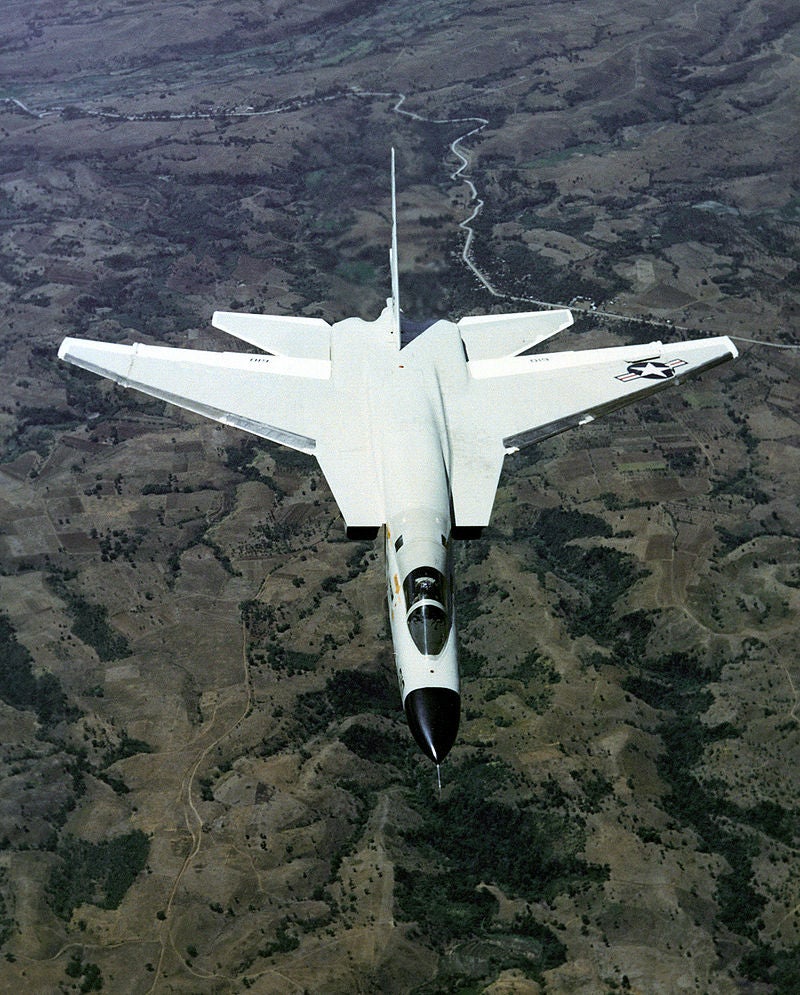
 McMike
> ttyymmnn
McMike
> ttyymmnn
09/02/2016 at 14:53 |
|
Forgive me.
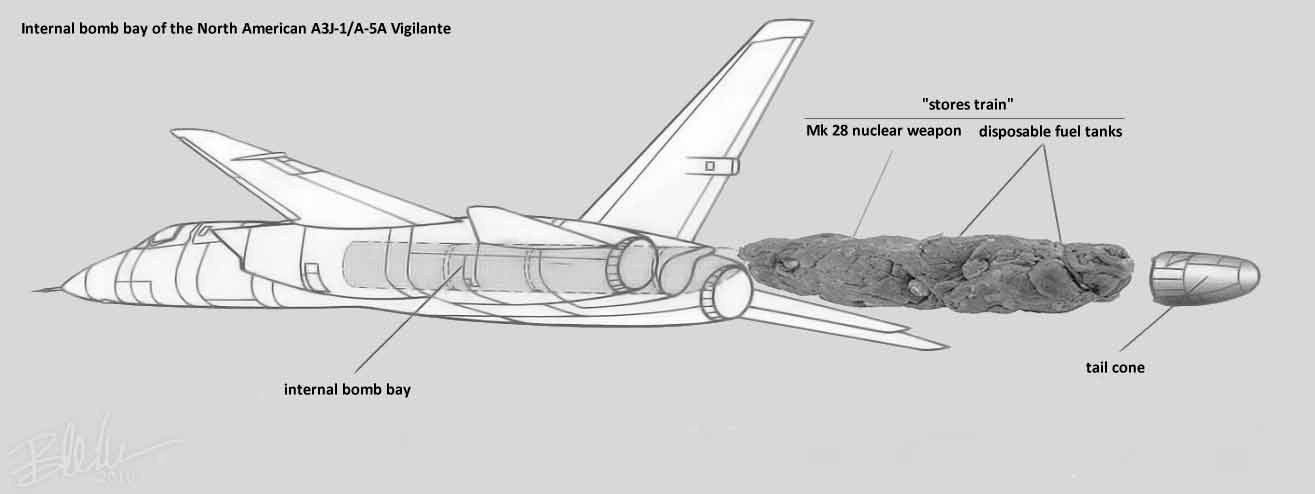
 ttyymmnn
> McMike
ttyymmnn
> McMike
09/02/2016 at 15:08 |
|
I expect nothing less.
 ttyymmnn
> You can tell a Finn but you can't tell him much
ttyymmnn
> You can tell a Finn but you can't tell him much
09/02/2016 at 15:09 |
|
You are correct about the crew. I will edit. Thanks for pointing that out.
 You can tell a Finn but you can't tell him much
> McMike
You can tell a Finn but you can't tell him much
> McMike
09/02/2016 at 15:29 |
|
What the shit McMike? Did you really need to drop that one on us?
 DarkCreamyBeer
> ttyymmnn
DarkCreamyBeer
> ttyymmnn
09/02/2016 at 18:02 |
|
I think it’s important to note that the flying boom system was originally used by SAC only (it allowed higher fuel transfer rates). Many USAF TAC aircraft were equipped for hose and drogue, including F-100s, AT-37s, and HH-3 Jolly Green Giants. The F-105 was equipped for both. It wasn’t until the F-4 that the USAF standardized on flying boom for fixed wing aircraft. Only probe and drogue is practical for helicopters.
 ttyymmnn
> DarkCreamyBeer
ttyymmnn
> DarkCreamyBeer
09/02/2016 at 18:15 |
|
It is worth noting, and I appreciate the added detail. I have to paint with some broad strokes sometimes, otherwise these would turn into Wikipedia articles!
Yes, P&D is the only way to refuel helos, but the probe can be shortened if the need arises.
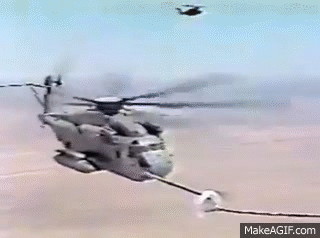
 DarkCreamyBeer
> ttyymmnn
DarkCreamyBeer
> ttyymmnn
09/02/2016 at 18:28 |
|
If it weren't for this post I'd never have realized that the F-105 could use both systems. It may be the only aircraft that ever could. I'm still digging for another example.
 ttyymmnn
> DarkCreamyBeer
ttyymmnn
> DarkCreamyBeer
09/02/2016 at 18:39 |
|
If you find one, please let me know. Thanks.
 DarkCreamyBeer
> ttyymmnn
DarkCreamyBeer
> ttyymmnn
09/02/2016 at 18:51 |
|
Some USAF A-7s may also have been dual equipped, and apparently Spain and possibly Israel retrofitted F-4s with probes.
 John Norris (AngryDrifter)
> ttyymmnn
John Norris (AngryDrifter)
> ttyymmnn
09/02/2016 at 22:03 |
|
Great article.
There is something I must add. Sorry.
Initially, the Russians said nothing about the shoot down, believing that their role could not be proven. Eventually, they admitted to downing the airliner, alleging that it was part of a planned intelligence gathering mission, and suggesting that the fighter pilots had mistaken the airliner for a
Boeing RC-135
reconnaissance plane, one of which actually was operating in the area at the time.
It was more than that, they flat out denied it. Then Reagan called them out by having Ambassador Jean Kirkpatrick tell the UN and the world what really happened and then she played a recording of the Russian pilot’s and military leadership communications to prove it.
Here is how she introduced it. Unfortunately you have to pay somebody to get the shot of the two Russians listening to the recording once the evidence was on the table and their government was caught in the lie.
Here is the audio and a translation of the Russian communications.
 ttyymmnn
> John Norris (AngryDrifter)
ttyymmnn
> John Norris (AngryDrifter)
09/02/2016 at 22:20 |
|
Thanks for the extra details. As I’ve said to others, I have to paint with pretty broad strokes with these articles. I could have gone into all the political back and forth, the denials, and it’s really at the heart of whole Cold War struggle surrounding this event (I was 17 when this happened, and I remember it well. It was kind of trippy being a teenager as the Cold War drew to a close). But that would have doubled the length of the post. It’s always a balancing act to write in a limited space. I tried to hint at the Russian obfuscation, while ultimately saying that they did come clean about it, in a very Soviet sort of way. So there’s a whole lot of detail behind my one sentence, and I’m glad you provided the videos. I just couldn’t.